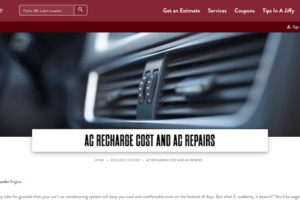One fine day, you are in a hurry. You will be late for work, so you quickly grab your things and rush to your car. Unfortunately, the engine won’t start. Then you start to wonder – why is my car having trouble starting?
The following are some of the most common causes when your car is having trouble starting:
- Battery Problems
- Faulty Alternator
- Lack of Fuel
- Defective Ignition Switch
- Damaged Timing Belt
- Clogged Fuel Filter
- Starter Issues
- Solenoid Failure
To fix the problem, start by charging or jump-starting the battery. You might also need to repair or replace the problematic components, such as the alternator, ignition switch, fuel filter, starter, and solenoid. The solution can also be as simple as refilling the fuel tank.
Read on to learn more about cars having trouble starting, including the possible causes and potential fixes. In most instances, you can solve it yourself without paying a mechanic.
Car Having Trouble Starting – Possible Causes and Solutions

It is frustrating when your car won’t start, especially when rushing to leave. Do not panic. Instead, consider the following issues and quick fixes:
1. Battery Problems
The most common culprit for starting problems is the battery. It provides the electricity necessary for different components to work. Its chemical reaction is what will put your vehicle in action. Hence, with a dead or low battery, your car may not start.
Causes of Dead Battery
A car’s battery can die because of different reasons, including the following:
- Leaving the interior and headlights on
- Exposure to a harsh environment
- Parasitic drain
- Terminal corrosion
- Parking the car for an extended period
- Taking a lot of short drives
- Poor condition or old age
Signs That the Car Won’t Start Due to Battery Issues
Meanwhile, aside from the car not starting, here are the signs that the problem lies in the battery:
- Lights are flickering or not turning on
- Radio is not working
- Clicking noise upon turning the key
- Swollen battery case
- Corroded terminals
- Dashboard warning light
- Engine backfiring
How to Fix
To revive a car battery, below are some of the best things to do:
- Use a Jump-starter: Do this on an even surface with both cars in neutral or park. Make sure that the engine is off. Connect the clips to the right terminals. Allow the car with the problematic battery to run for about 15 minutes to charge the battery.
- Add Epsom Salt: This is another effective solution, especially if the reason for the dead battery is a low electrolyte. It is a strong acid with hydrating benefits while improving the chemical balance. Mix one-part Epsom salt with three parts distilled water and add it to the battery.
- An Aspirin Solution Can Also Work: Like the Epsom salt, it alters the battery’s chemical mix. Dissolve aspirin tablets in warm water and add to each battery cell, ensuring that it is sufficient for plate coverage.
2. Faulty Alternator
The battery isn’t the only thing that ensures a car’s full functionality. Another crucial component is the alternator. It allows the car to stay on while the engine is running. This belt-driven part sparks to charge the battery. Any serious problem with the alternator can compromise the car, and hence, it might fail to run.
Signs of a Defective Alternator
As soon as the alternator is faulty, the engine suffers. While the most obvious symptom is the failure of the car to start, here are other things that are indicative of a defective alternator:
- An alternator warning light is on
- Lights are overly bright or dim
- Unusual noises
- Foul odor
- Engine stalling electrical issues
It is difficult to tell whether it is the battery or the alternator that has a problem. The tell-tale signs are almost the same. The easiest way to tell the cause is the sign in the dashboard light.
How to Fix
- To diagnose an alternator problem, you will need to check the voltage output. The right voltage should range from 13.5 to 14.5.
- You probably have a faulty alternator or a dead battery if the voltage reading is off.
- You can repair the alternator yourself if you have basic DIY knowledge.
- It might need a replacement when the damage is too severe. If you are not confident in your skills, it is best to take it to a mechanic.
3. Lack of Fuel
Another common issue is that your gas tank is empty. You might have parked your car too long or forgot to gas up during your last ride. If the tank is empty, it is apparent that you won’t start your car. It might start for a few seconds, but it will soon turn off.
Check the Fuel Tank Indicator
In most instances, the fuel tank indicator will show if your gas is empty or low. Nonetheless, the gauge can also be problematic, so it may not show the right information. More so, it may not be empty, but if you live in a place with extremely low temperatures, then the fuel might have frozen over time.
How to Fix
- Refill the fuel tank.
- Make sure that you are using the right fuel for your car.
- Use a car refueling funnel to fill the tank with gas while minimizing mess and staying safe.
- Alternatively, you can also use a hose to suction fuel from a container to the tank.
4. Defective Ignition Switch

An ignition switch has several functions. It lets you control the various connected accessories without draining electricity. It connects the starter and the battery while also allowing the latter to deliver the other parts’ power. Plus, it recognizes a vehicle’s anti-theft code, making it a great safety feature.
Symptoms of a Faulty Ignition
Below are some of the most common symptoms of a faulty ignition switch beyond the difficulty of starting:
- Key does not turn
- Engine stalling
- Starter has no noise
- Flickering dashboard light
- Intermittent lighting loss
How to Fix
Replacing an ignition switch is necessary for most instances:
- Start by disconnecting the battery terminals and removing the trim around the steering wheel.
- Take the steering wheel out and remove the ignition module cover.
- Take off the ignition switch by pressing the release pin and pulling it out.
- Insert the new part and put all parts back.
Again, what are the causes of a car having trouble starting? If your car doesn’t start, it might have a dead or dying battery, a faulty alternator, a starter problem, or rusty connection cables. Usually, it is difficult to tell whether you have an alternator or battery problem.
5. Damaged Timing Belt
The timing belt is another essential component that allows the engine to work at its peak. It connects the crankshaft and camshaft, assuming a vital role in controlling the valves and pistons of your car. It is a rubber band with teeth or notches that synchronize the movement of the valves.
Effects of Failing Timing Belt
Once the timing belt fails, you will notice various problems beyond trouble starting, which include the following:
- Engine misfiring
- Oil leaks
- Overheating
- Vibrations
- Rubbing, ticking, or squealing noises
- Check Engine Light is on
How to Fix
Like any other damaged component, replacing the timing belt is one of the best fixes. It wears out over time, especially under harsh driving conditions:
- Experts suggest that you replace the timing belt after 60,000 to 100,000 miles.
- Check the manual and follow the specific recommendations of your car’s manufacturer.
6. Clogged Fuel Filter
While it is small, the fuel filter is one of the most critical components in a vehicle’s fuel delivery system. In most vehicles, you will find two filters:
- In the main fuel line, and
- Fuel tank.
It is made of plastic or pleated paper; the filter strains impurities, including rust, scale, and debris. It makes sure that fuel is clean as it enters the engine, injectors, and pump.
Effects of Clogged Fuel Filter
With the contaminants passing through the fuel filter, it clogs over time. As a result, it makes it difficult for the engine to start. It is also the reason for various problems, including the following:
- Inferior engine performance
- Engine stalling
- Rough idling or misfiring
- Failure of fuel system parts
How to Fix
As with the other parts responsible for starting problems, a replacement may be necessary. Replacing the fuel filter is cheap, which is approximately $20:
- You will need to disassemble, clean, and flush the filter.
- In some cases, you can still salvage and clean it. Meanwhile, the best solution is a replacement if the build-up is severe.
7. Starter Issues
The car starter is another suspect when your car is having starting problems. It is a small battery-powered motor that transmits power and starts the engine. If it is not working correctly, then the engine won’t run.
Signs of Start Issues
Over time, the starter will wear out. Nonetheless, it is not often sudden. You will notice some tell-tale symptoms beyond the engine not starting, including the following:
- Dim interior lights
- Grinding noise
- Whining or whirring engine when cranking
- Burnt smell
- Smoke
How to Fix
To know if the starter is the problem:
- Open the hood and inspect.
- Tap the starter lightly using a hard object but do not apply excessive force. This will bring it back up.
- You might also need to adjust the transmission and check the fuel gauge.
8. Solenoid Failure

When you start your car, all you do is turn the key, and the engine will start. Behind this, however, is a complex mechanism that involves different components, including a solenoid. It receives electrical currents from the battery and ignition system. When you turn the key, the solenoid closes two metal points to start the motor.
Symptoms of Solenoid Failure
With frequent movements and exposure to harsh environments, the solenoid is damaged over time. Aside from the engine cranking and not starting, its failure also has the following symptoms:
- A clicking sound
- Starter rotation without the drive gear reversing
- The spinning of the starter motor
How to Fix
To determine if the solenoid is the problem, you must perform a quick test:
- Use a circuit tester or multimeter to ensure power transmitting in the positive circuit. It may have voltage, but the latter is too low to allow the other parts to work.
- If it is not working, then you might need a replacement.
- Before doing so, you will need first to disconnect the battery so you can complete the task safely. It is also crucial to choose a high-quality solenoid to deliver peak performance.
Why Does My Car Turn Off When I Stop?
Conclusion – Car Having Trouble Starting [Causes and How to Fix]
If your car doesn’t start, do not panic. Instead, consider the following culprits:
- Battery Problems
- Faulty Alternator
- Lack of Fuel
- Defective Ignition Switch
- Damaged Timing Belt
- Clogged Fuel Filter
- Starter Issues
- Solenoid Failure
One of the first things to look at is the battery, ensuring that it isn’t dead. You might need to replace any defective component, such as the alternator, ignition switch, timing belt, fuel filter, and starter.
Read next:
Car Won’t Turn Over but Has Power [Causes and How to Fix]









